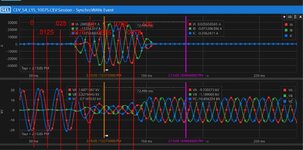There was fault on this feeder breaker. The instantaneous relay was set at 18000 amps. There was no load on the feeder.
Was the wave decaying on it's own then it tripped ? Or is the last part of the top current wave when the breaker tripped ?
Another question is ... WHY is VB at 0V before the fault ? Is this indicating a ground fault on the B phase ?
The system this is fed from is a 138Y-15D kV ungrounded transformer, but has installed at the first switchgear, upstream from the faulted switchgear, a grounding transformer (15YG-.480D kV) through a 300A, 29ohm resistor.

Was the wave decaying on it's own then it tripped ? Or is the last part of the top current wave when the breaker tripped ?
Another question is ... WHY is VB at 0V before the fault ? Is this indicating a ground fault on the B phase ?
The system this is fed from is a 138Y-15D kV ungrounded transformer, but has installed at the first switchgear, upstream from the faulted switchgear, a grounding transformer (15YG-.480D kV) through a 300A, 29ohm resistor.


